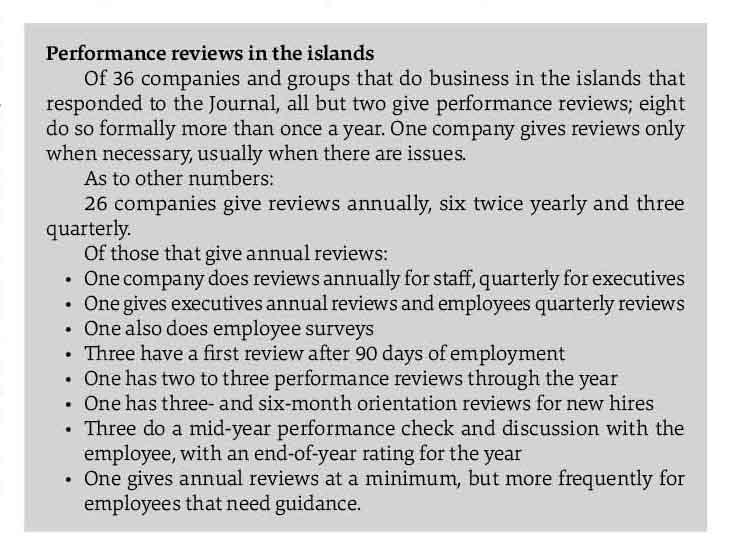Journal Staff
If there’s one thing that can make the whole team quiver — from managers to the lowest employee on the ladder — it’s performance reviews.
So much has been written about performance reviews that it’s breathtaking. Peter Drucker, the Austrian American management consultant — also known as “the father of modern management theory” wrote about the topic, and the Harvard Business Review has published books managers can turn to. That’s just the tip of the iceberg.
The subject has been widely studied for decades.
In-person meetings seem to show the best results, but employees are often dissatisfied with feedback, and performance reviews do not necessarily improve performance.
While it seems productive to provide immediate feedback to employees, few companies do so.
According to Slideshare, performance reviews typically cover job knowledge, dependability, quality of work, communication skills, quantity of work, attendance, punctuality, adaptability, time allocation, professionalism and working relations.
Slideshare also offers prompt questions for leaders. These are, What have I done to help — or hinder — your job performance? What can I do in the next review period to help you achieve/improve? What conditions here enable you — or make it hard — to do your best work? What do you want most from your job? And How can I help you reach your career goals? Slideshare also offers suggestions on responses by employees.
Performance reviews are given in 23 countries, and the performance review is alive and well in the islands.
The latest trend is to give employees ongoing timely feedback through the year, rather than the annual session for a performance review.

But one in four employees believe their performance reviews were negatively affected by their supervisor’s personal biases, according to an October 2023 survey of more than 1,000 full-time workers from Syndio, a technology company that helps employers analyze race- and gender-based pay gaps.
The data on gender is even less encouraging.
Numerous studies have shown that women are often evaluated based on their personality and likeability, while men are evaluated on their accomplishments and potential. Women get personality advice, while men get actionable advice.
There’s more.
A 2022 Textio research project on workplace language biases found distinctive patterns of feedback bias for certain groups of people: women, Black people, Latino/a people, and older workers; 100% of women, non-binary, and gender fluid people reported receiving personality feedback.
The Harvard Business Review found in 2021 that men get more actionable feedback than women. Men are also encouraged to be assertive, while females are encouraged to be cooperative, Harvard found.
And 88% of high-performing women received feedback on their personality during performance reviews — compared with 12% of high performing men, Textio found.
Smaller recent studies have found that some managers are more lenient with female employees, to compensate for any inadvertent bias.

“It’s more conversational; it’s more personal … rather than just going down a check list,” he said.
According to the Society for Human Resource Management, 93% of organizations conduct employee performance reviews, with 71% of them doing so annually. According to Workhuman Analytics & Research, 55% of workers do not think performance reviews actually improve performance. Less than half of North American employers believe their managers are effective at assessing their direct reports’ performance, according to the WTW 2022 Performance Reset Survey.
About 47% of performance reviews are given past their due date, and of those 50% were overdue by 30 days or more, according to Zensai.
That’s a pity.
A 2021 study by Lampe et al, found that feedback can change employee behavior especially when it includes high-quality messages (i.e., messages that are specific and relevant to performance), as it can help employees interpret the appropriateness of their behaviors and take actions to improve their performance.
There is an organizational cost to performance reviews, given the time they take.
Many managers and HR leaders are moving away from annual reviews. Some high-profile companies like Block/Twitter, Yahoo, GE, Deloitte, Gap, Netflix, Microsoft and Apple have eliminated performance reviews altogether.
A significant number of organizations have also promoted the use of technology (e.g., computers, mobile applications, etc.) to assist managers in delivering feedback to employees in a timely fashion.
Camacho said, “Performance reviews — at least nationally — are on the decline. Many companies are now focusing on overall productivity rather than individual production as a metric. I understand this trend is due to the hybrid workplace issue that many companies have implemented. It makes it difficult to evaluate individual performance when no one sees you.”
(On Feb. 5, employment website Indeed advertised 22 hybrid positions in Guam.)
While performance evaluations continue, there may be changes, he said.
“I am not sure performance evaluations are going to cease, but I think we will see different ways of measuring performance that we had in the past. One of the changes we are seeing is, more managers address issues when they come up, rather than wait.”
Content has also shifted, Camacho said with evaluations no longer quantitative but rather about production numbers, key points and goals. “It’s not about punctuality or personality.”
Outside factors are also affecting reviews, he said.
“Additionally, as we see a shift in the compensation and benefits area, the reasons for performance evaluations are needed less. … Instead of ranking, there’s more employee development. That’s the added value employees are looking for.”
In general, Camacho said the challenge is, “How do we address the competitive market?” A major competitor for employees is the federal government, which typically has formats and processes for recruiting, while the private sector can be flexible, he said.

“Companies can leverage their ability to make decisions ‘on the fly’ and transform workplaces,” he said.
Typically, about 50,000 Guam residents are not working or seeking work, according to recent Government of Guam reports.
“That’s a pool of people,” he said. “A lot of them don’t want to work because they’ll lose welfare benefits. The private sector has the ability to come up with jobs. It could be part time.”
There is one purpose that reviews can contribute to, Camacho said.
“You do need documentation whenever you make employment decisions.”
Documentation shows decisions are being made on a rational basis, he said, particularly if there are possible legal situations. “One of the hot topics now is pay disparity, so you want it documented so there’s no appearance of bias.” mbj



















